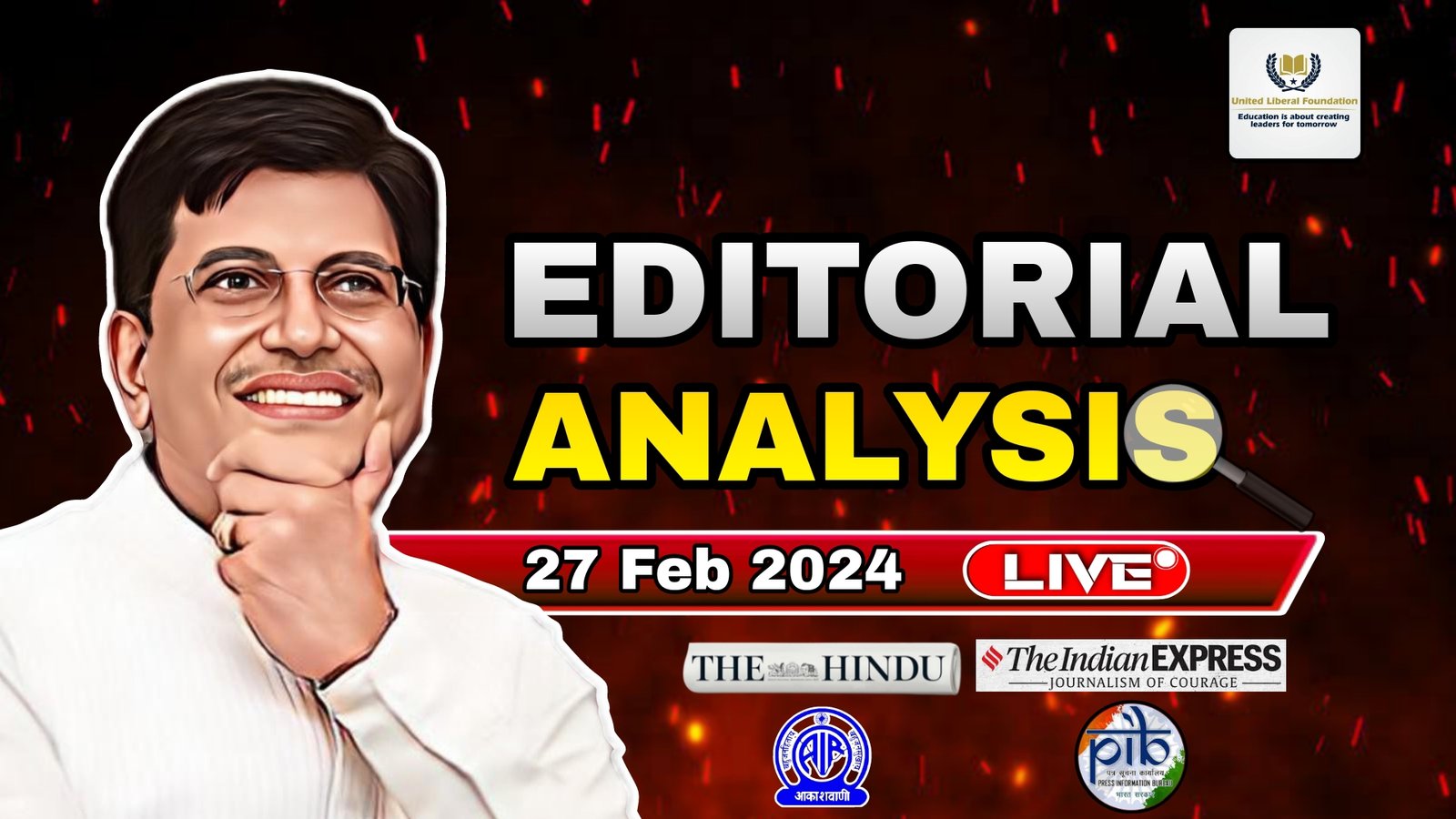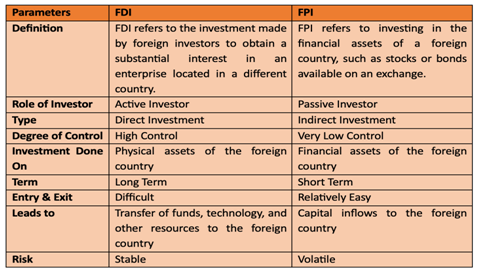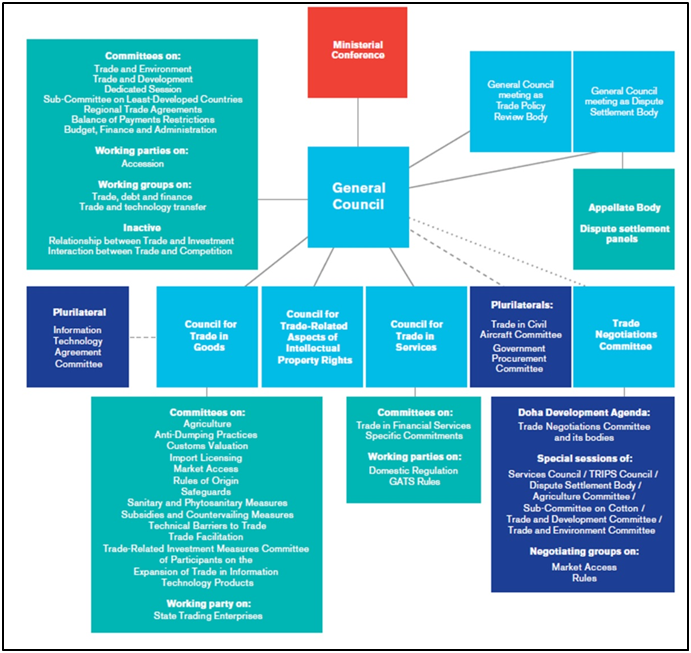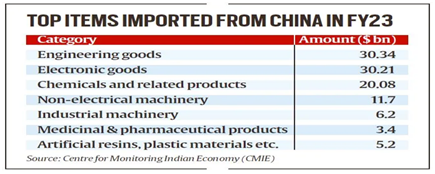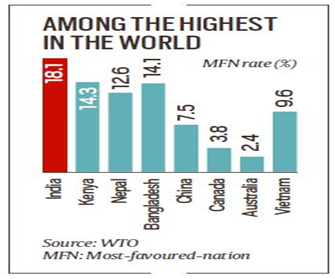Editorials & Articles – 27 Feb 2024
Drop the ‘garland model’ to let science in India blossom

| Context |
|
Reimagining Scientific Meetings in India The Role of Scientific Meetings:
- Scientific meetings or conferences are crucial for researchers to share and discuss their findings.
- These meetings often include presentations, talks, and expert interactions on various scientific topics.
The Standard Academic Meeting Model:
- Traditionally, a core group of organizers, often a scientific society, takes responsibility for planning, inviting experts, disseminating information, and managing finances.
- Invited speakers, typically leading researchers, and other researchers paying a fee participate in these meetings.
Modern Trends in Scientific Conferences:
- Contemporary conferences emphasize non-hierarchical interactions, career-stage equity, diversity, and sustainability, in addition to scientific discourse.
- India hosts numerous scientific conferences across various fields, organized by scientific communities and societies.
Challenges with Scientific Conferences in India:
- Outdated Bureaucratic Frameworks:
- Conferences often involve institute administrators and hierarchical organization of organizers.
- Proceedings feature lengthy talks by administrators, late starts, and segregated seating.
- Gift-giving rituals and religious ceremonies are prevalent.
- Lack of Inclusivity and Diversity:
- Scientific programs may lack gender and diversity representation, featuring all-male panels and focusing solely on “women in science” without addressing broader issues.
Examples of Reimagined Conferences:
- No Garland Neuroscience (NGN): This prioritises scientific content and discussions while maintaining a simple, cost-effective approach.
- Young Investigators’ Meeting (YIM): This series focuses on scientific networking and mentorship among life scientists, promoting features like alphabetical speaker lists, round-table seating, gender equality, and open interactions.
The Need for Revamp:
- The persistence of outdated practices hinders scientific progress and fosters inequities.
- Reimagining conferences could promote inclusivity, accessibility, and sustainability.
- This revamp would signal India’s commitment to contemporary scientific practices and global collaboration.
Conclusion:
- Revamping scientific conferences in India is necessary to foster a more inclusive, equitable, and progressive scientific culture.
- This change would not only benefit the Indian scientific community but also project India as a leading player in the international scientific landscape.
An expansive land management policy is overdue

| Context |
|
The Importance of Sustainable Land Management Practices in India Land: A Multifaceted Resource:
- Land is crucial for human activities, providing ecological, economic, social, and cultural services.
- However, overlooking its multi-dimensionality leads to land degradation and environmental issues.
Global Context:
- Land degradation costs the world an estimated $6 trillion annually.
- The UN Convention to Combat Desertification (COP14) and the IPCC highlight the need for land management solutions.
- The FAO report, “State of the World’s Land and Water Resources for Food and Agriculture,” urges immediate action for sustainable land management.
Challenges in India:
- India faces land management challenges due to its large population and limited land resources.
- Arable land and forest cover are limited, while 30% of the land is already degraded.
- Development needs, population growth, and rapid urbanization create pressure on land.
- This leads to competition, land-use conflicts, and compromised environmental functions.
- Climate change presents additional challenges.
Current Practices and Challenges:
- Land management is:
- Sectoral, with each department having its own approach.
- Primarily under the purview of State governments.
- Cultural land is privately owned, with land-use decisions resting with the owner.
- Challenges include:
- Knowledge gaps
- Short-term planning bias
- Fragmented approach
- Lack of action for unforeseen events
- Regulatory barriers
Proposed Solutions:
- Multi-stakeholder platforms:
- Establish platforms at district and sub-district levels involving various stakeholders.
- Leverage Article 243ZD(1) of the Constitution for district planning committees.
- Landscape approach:
- Gain insights into land potential and allocation for appropriate uses.
- Facilitate evaluation, negotiation, and decision-making.
- Integrate climate change considerations for combined benefits.
Institutional Support:
- Science and global experience support integrated landscape management.
- The European Landscape Convention emphasizes the importance of landscape for well-being.
- The U.K. Parliamentary Office of Science and Technology highlights the need for better land management policies.
- Indian parliamentarians can initiate discussions for long-term sustainable land management practices involving all stakeholders.
Conclusion:
- India needs to prioritize sustainable land management practices by fostering collaboration, adopting a landscape approach, and seeking institutional support.
- This will ensure long-term environmental and economic benefits for the nation.
It starts with the district

| Context: |
|
District Development Index for Maharashtra: A Multidimensional Approach:
- The District Development Index for Maharashtra offers policymakers a nuanced understanding of district-level progress by considering both the potential for socio-economic development and the current levels of development.
- This index provides a comprehensive snapshot of district performance, enabling policymakers to identify areas of improvement and harness the untapped potential present in various districts across the state.
Population Dynamics: Governance Challenges and Opportunities:
- With an average district population of nearly 1.86 million people, larger than the populations of entire countries like Singapore and the UAE, governance at the district level becomes immensely complex.
- However, strides in socio-economic indicators, such as education and financial access, demonstrate notable progress made at the district level, highlighting the need for localized policy interventions.
Inter-district Disparities: Insights from Data Analysis:
- Studies conducted shed light on inter-district variations in developmental outcomes, showcasing instances of both progress and disparity across different states.
- Such analyses are crucial for policymakers to identify areas requiring targeted intervention and to ensure equitable development across all districts.
Income Disparities and Urban-Rural Divide:
- Evidence from reports like the Competitiveness Roadmap for India underscores significant income disparities across districts, with urban districts disproportionately contributing to economic activity.
- Addressing these disparities requires a nuanced approach that considers both top-down policies and bottom-up initiatives tailored to the specific needs of each locality.
Policy Responses: Balancing Top-Down and Bottom-Up Approaches:
- Effective policy responses must strike a balance between top-down initiatives aimed at addressing broader socio-economic challenges and bottom-up interventions tailored to local contexts.
- Initiatives like the Aspirational Districts Programme exemplify efforts to address critical gaps and foster collaboration among stakeholders to target localized challenges in health, education, agriculture, and other key sectors.
Harnessing District-level Potential: Towards Clusters of Growth:
- Unlocking district-level productivity and value creation necessitates moving beyond one-size-fits-all policies.
- Schemes like the One District One Product programme aim to leverage local resources and expertise to promote economic growth at the district level.
- Additionally, creating linked industries and institutions within industrial clusters can catalyze value creation and foster sustainable growth.
Conclusion:
- As India strives for inclusive and sustainable development, it is imperative for policymakers to recognize the diversity of its districts and tailor interventions accordingly.
- By harnessing localized data, fostering collaboration, and implementing targeted policies, districts can emerge as drivers of growth, contributing to the vision of a developed and equitable India.
Instead of electoral bonds

| Context: |
|
Analysis of Supreme Court Verdict: Implications and Legal Context:
- The Supreme Court’s judgment underscores the longstanding principles governing corporate funding in Indian politics, as outlined in the Companies Act.
- While companies were permitted to donate to political causes under certain conditions, such as generating profits and obtaining appropriate board resolutions, the essence of disclosure was never compromised.
- However, amendments introduced by the impugned law distorted these fundamental principles, perpetuating inequalities and undermining transparency.
Broader Implications of the Judgment: Towards Systemic Reform:
- Beyond the legal intricacies, the judgment prompts a broader reflection on the motives behind legislative initiatives and their alignment with stated objectives.
- The EBS, purportedly introduced to enhance transparency in electoral funding, paradoxically fostered a culture of secrecy.
- Justice Sanjiv Khanna’s dissent emphasizes the importance of legislative intent and cautions against ulterior motives such as retribution or retaliation.
Institutional Integrity and Government Oversight:
- The judgment also raises concerns about the integrity of institutions tasked with safeguarding public interest.
- Contradictory stances from entities like the Reserve Bank of India (RBI) and the Election Commission underscore the need for independent scrutiny and vigilance.
- The refusal to stay the EBS highlights the erosion of the right to information and the encroachment on democratic values by governmental authorities.
Challenges to Democratic Processes and Electoral Integrity:
- A critical aspect highlighted in the judgment is the potential for the EBS to distort electoral processes and disenfranchise smaller political parties.
- The infusion of unregulated funds threatens to undermine the democratic fabric by favoring entrenched interests and marginalizing alternative voices.
- The judgment’s implications for the prevalence of cash-based funding and the role of money in shaping voter behavior warrant careful consideration.
Future Prospects and Legislative Reforms:
- Looking ahead, the annulment of the EBS presents an opportunity for systemic reform in political funding.
- However, merely rescinding the scheme may not suffice to restore a level playing field.
- Collaborative efforts involving all stakeholders are imperative to devise alternative mechanisms that uphold democratic values and ensure transparency in political finance.
Conclusion:
- The impending unveiling of truth carries significant implications for India’s democratic ethos and governance.
- The Supreme Court’s verdict underscores the imperative of legislative accountability and the preservation of democratic principles.
- As the nation awaits further developments, the onus lies on the new Parliament to enact laws that reflect the spirit of judicial scrutiny and uphold the integrity of India’s democratic framework.
| What are Electoral Bonds? |
About:
Donations Through Electoral Bonds:
Eligibility to Receive Funds via Electoral Bonds:
|
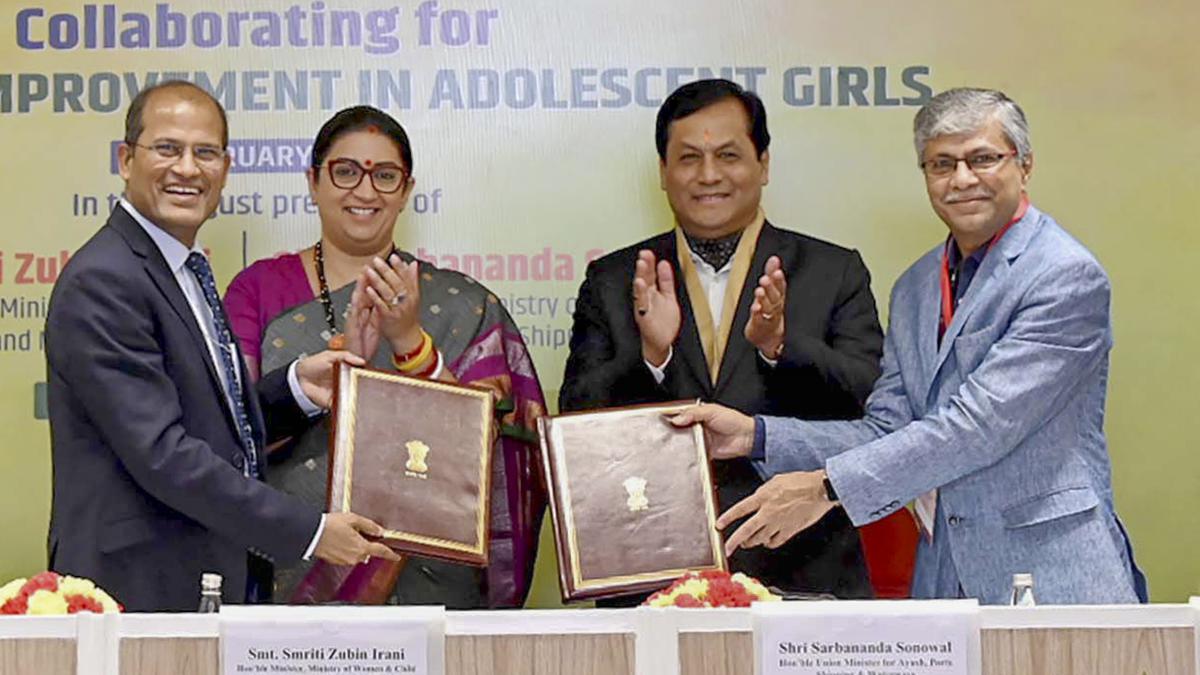
Why in news?
- Ministry of Ayush and Ministry of Women and Child Development have signed a MoU for the nutritional improvement in adolescent girls through Ayurveda Interventions.
- It will be a Joint Public Health Initiative for Anaemia Control among adolescent girls using Ayurveda interventions in the five districts under Mission Utkarsh.
What’s in today’s article?
- Anaemia
- News Summary
What is Anaemia?
- About
- According to the WHO, anaemia is a condition in which the number of red blood cells or the haemoglobin concentration within them is lower than normal.
- Haemoglobin is needed to carry oxygen.
- If there are too few red blood cells, or not enough haemoglobin, there will be a decreased capacity of the blood to carry oxygen to the body’s tissues.
- This results in symptoms such as fatigue, weakness, dizziness and shortness of breath among others.
- Factors
- The most common nutritional cause of anaemia is iron deficiency although deficiencies in folate, vitamins B12 and A are also important causes.
- Certain chronic diseases, such as kidney disease, liver disease, cancer, or autoimmune disorders, can interfere with the production of red blood cells.
- Inherited conditions, such as sickle cell anemia or thalassemia, affect the structure or function of red blood cells, leading to chronic anemia.
- Why should there be focus on Anaemia?
- Impact on morbidity and morality
- Anaemia is related to morbidity and mortality in the population groups usually considered to be the most vulnerable — pregnant women and children under five.
- Effect on reproductive health
- A prevalence study on anaemia is useful to monitor the progress of reproductive health.
- Impact on economy
- Iron-deficiency anaemia reduces the work capacity of individuals and entire populations.
- Impact on morbidity and morality
India’s anaemia burden
- India’s anaemia burden has grown alarmingly with NFHS-5 (2019-21) finding that:
- 57% of women in the age group 15-49 and 67% children between six months and 59 months are anaemic (from the corresponding 53% and 58.6% respectively in NFHS-4 (2015-16)).
- The Health Ministry has noted that anaemia is a public health challenge.
News Summary: Mission Utkarsh – Initiative for Anaemia Control among adolescent girls using Ayurveda interventions
- The Centre launched an initiative to improve nutrition in adolescent girls (14-18 years) using Ayurveda.
Key highlights of Mission Utkarsh
- 15 central ministries or departments to work together
- To elevate districts at the bottom, to state and national averages.
- To be launched in five aspirational districts
- Initially, it would be launched in five aspirational districts (of five states) first as a pilot project.
- Aspirational Districts are a part of a developmental initiative introduced by the Government of India.
- The program aims to transform the most underdeveloped districts of the country by focusing on improving their socio-economic indicators.
- These districts, often characterized by high poverty rates, lack of basic infrastructure, and limited access to essential services.
- These are:
- Assam (Dhubri), Chhattisgarh (Bastar), Jharkhand (Paschimi Singhbhum), Maharashtra (Gadchiroli), and Rajasthan (Dhaulpur)
- Initially, it would be launched in five aspirational districts (of five states) first as a pilot project.
- Target group
- The aim is nutritional improvement among approximately 95,000 adolescent girls in anaemia prone districts.

Why in the News?
- The markets regulator Securities and Exchange Board of India (SEBI) has warned individuals against fraudulent trading platforms.
- The SEBI has warned that certain trading platforms are falsely claiming or suggesting affiliation with its registered Foreign Portfolio Investors (FPIs).
What’s in Today’s Article?
- About FPI (Basics, Benefits, Comparison with FDI, etc.)
- News Summary
What is Foreign Portfolio Investment (FPI)?
- Foreign Portfolio Investment (FPI) involves an investor buying foreign financial assets. It involves an array of financial assets like fixed deposits, stocks, and mutual funds.
- All the investments are passively held by the investors. Investors who invest in foreign portfolios are known as Foreign Portfolio Investors.
- Foreign Portfolios increase the volatility. As a result, it leads to increased risk.
- The intent of investing in foreign markets is to diversify the portfolio and get good return on investments.
- Investors expect to receive high returns owing to the risk they’re willing to take.
- Securities and Exchange Board of India (SEBI) operates the FPIs.
- Recently, SEBI has introduced the Foreign Portfolio Investors Regulations, 2019.
- FPIs also need to follow the Income-tax Act, 1961 and Foreign Exchange Management Act, 1999.
Benefits of FPI:
- Investment Diversity:
- FPI provides investors an opportunity to diversify their portfolio.
- As an investor, you can diversify your portfolio to achieve high returns.
- Suppose if you incur major losses in investment assets of a Country X, you can accrue profits in investment assets of a country Y.
- In this way, you can experience less volatility in your investments and increase chances of profits.
- International Credit:
- Investors can get access to increased amounts of credit in foreign countries.
- They can broaden their credit base. By expanding their credit base, investors can secure their line of credit.
- In case the domestic credit score is unfavorable, having an international credit score can be beneficial.
- This allows the investor to utilize more leverage and get high returns on equity investment.
- Access to a Bigger Market:
- Sometimes, foreign market can be less competitive than the domestic market.
- Hence, FPI gives you an exposure to a wider market.
- The foreign markets are comparatively less saturated and hence, they may offer higher returns and more diversity as well.
- High Liquidity:
- Foreign Portfolio Investments provides high liquidity.
- An investor can buy and sell foreign portfolios seamlessly.
- This offers buying power for investors to act when good buy opportunities arise.
- Investors can buy and sell trades in a quick and seamless manner.
- Exchange Rate Benefit:
- An investor can leverage the dynamic nature of international currencies.
- Some currencies can drastically rise or fall, and a strong currency can be used in investor’s favour.
Difference Between FPI and FDI:
News Summary:
- The markets regulator Securities and Exchange Board of India (SEBI) has warned individuals against fraudulent trading platforms falsely claiming or suggesting affiliation with its registered Foreign Portfolio Investors (FPIs).
- These platforms are misleading individuals by claiming to offer them trading opportunities through FPI or Foreign Institutional Investor (FII) sub-accounts or institutional accounts with special privileges.
- The SEBI said it has received many complaints where fraudsters are enticing victims through online trading courses, seminars, and mentorship programmes in the stock market.
- They are leveraging social media platforms like WhatsApp or Telegram, as well as live broadcasts.
- These scamsters are posing as employees or affiliates of SEBI-registered FPIs, and coaxing individuals into downloading applications.
- These applications purportedly allow them to purchase shares, subscribe to IPOs, and enjoy ‘institutional account benefits’—all without the need for an official trading or Demat account.
- These operations often use mobile numbers registered under false names to orchestrate the fraudulent schemes, SEBI, said.
SEBI’s Clarification:
- The market regulator clarified that the FPI investment route is unavailable to resident Indians, with limited exceptions as outlined in the SEBI (Foreign Portfolio Investors) Regulations, 2019.
- SEBI has not granted any relaxations to FPIs regarding securities market investments by Indian investors.
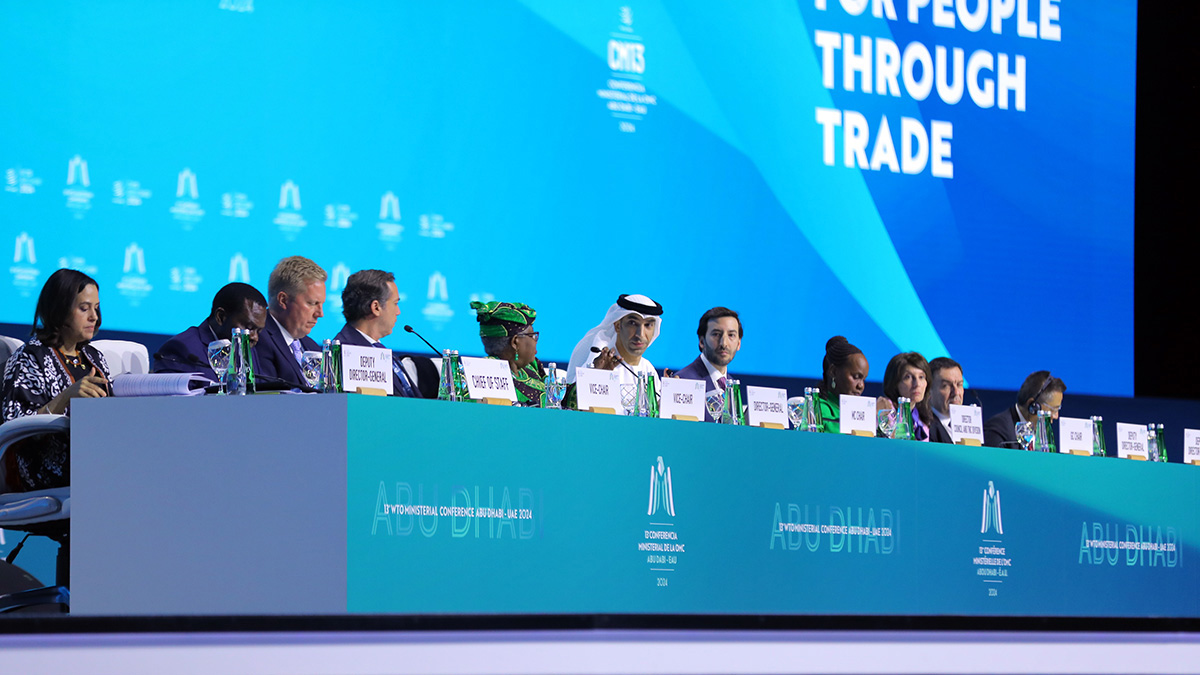
Why in news?
- The four-day 13th ministerial conference (MC13) started on February 26 in Abu Dhabi, the United Arab Emirates (UAE).
- The Indian delegation is led by Commerce and Industry Minister Piyush Goyal.
What’s in today’s article?
- WTO
- 13th ministerial conference (MC13) of WTO
- News Summary
About World Trade Organization (WTO)
- WTO is the only global international organization dealing with the rules of trade between nations.
- The goal is to help producers of goods and services, exporters, and importers conduct their business.
- WTO is a forum for governments to negotiate trade agreements. It is also a place for them to settle trade disputes.
- It was created by Uruguay Round negotiations (1986-94) and is headquartered in Geneva.
Functions of WTO
- Administering trade agreements
- Acting as a forum for trade negotiations
- Settling trade disputes
- Reviewing national trade policies
- Building the trade capacity of developing economies
Structure of WTO
- The WTO has 164 members, accounting for 98% of world trade.
- Accession processes for Comoros and Timor-Leste are nearing completion, paving the way for their WTO entry.
- Decisions are made by the entire membership. This is typically by consensus.
- The WTO’s top-level decision–making body is the Ministerial Conference, which meets usually every two years.
13th ministerial conference (MC13) of WTO
- MC13 of WTO will take place from February 26–29, 2024 in Abu Dhabi, United Arab Emirates.
- The conference will bring together trade ministers from around the world to:
- Review the functioning of the multilateral trading system
- Take action on the future work of the WTO
- Chart the future course of the WTO
News Summary: WTO MC13 – Agenda for India
India’s agenda at the meeting
- Food security issues
- Under the public stockholding (PSH) programme, the Government procures crops like rice and wheat from farmers at a minimum support price (MSP), and stores and distributes foodgrains to the poor.
- India stresses the need for PSH for its large, vulnerable population and wants a permanent solution from the MC13.
- Food procurement, stockholding, and distribution are crucial to India’s food security strategy.
- MSP is normally higher than the prevailing market rates and sells these at a low price to ensure food security for over 800 million beneficiaries.
- However, the WTO’s Agreement on Agriculture limits the ability of a government to purchase food at MSP.
- Under global trade norms, a WTO member country’s food subsidy bill should not breach the limit of 10 per cent of the value of production based on the reference price of 1986-88.
- As part of the solution, India has asked for measures like amendments in the formula to calculate the food subsidy cap.
- However, developed nations are of the view that such programmes distort global trade prices of food grains.
- Joint Support Initiatives (JSIs) or plurilateral agreements
- India opposes this move being pushed for certain nations.
- E.g., India is strongly opposing the efforts of a group of countries led by China to push a proposal on investment facilitation for development agreement at the WTO.
- India has maintained that this agenda falls outside the mandate of the global trade body.
- India opposes this move being pushed for certain nations.
- Agricultural reforms
- India’s stance is to protect farmer livelihoods and ensure equitable market access.
- However, developed nations are pushing to reduce domestic support and increase market openness irrespective of the fact that they provide large subsidies to their rich farmers.
- WTO reforms
- India supports fair reforms that take into account the needs of developing countries.
- This is in response to proposals from developed nations for easier negotiation processes, moving away from unanimous decision-making, and adding non-trade issues to the WTO without agreement from everyone.
- India supports efforts to improve the working of the WTO but its key pillars to be retained. These pillars are:
- special and differential treatment for less developed and developing nations,
- equal voice and
- dispute settlement mechanism.
- India also seeks a revamp of the Appellate Body to ensure fairness.
- Fisheries subsidies
- The members have already reached the first part of the agreement in 2022 under which subsidies will be prohibited for illegal, unreported and unregulated (IUU) fishing.
- Now they are negotiating to curb subsidies that contribute to overfishing and overcapacity to promote sustainable fishing.
- India champions a balanced approach on the principle of common but differentiated responsibilities.
- India, being a low fisheries subsidizer, emphasizes that advanced fishing nations have historically provided substantial subsidies and contributed to fish stock depletion.
- Hence, they should bear more responsibility based on the ‘polluter pay principle’.
- India has proposed that:
- developing countries be allowed to give subsidies to their poor fishermen to catch fish till EEZs or up to 200 nautical miles from the shore;
- rich countries engaged in fishing beyond this zone should stop providing any kind of subsidies for the next 25 years.
- Extension of customs duties moratorium on e-commerce trade
- The ongoing moratorium on customs duties on electronic transmissions, in place since 1998, is a contentious issue facing the WTO.
- India, alongside several other developing nations, has historically called for the termination of the moratorium.
- India has specific demands at MC13 to achieve this goal.
- Developed nations, however, are pushing for the permanent adoption of a duty-free flow of digital transmission.
- Barriers to trade
- India would maintain its stand that issues like labour, and environment are non-trade issues and they should not be discussed at the WTO.
- It also emphasised that trade barriers like the EU’s carbon tax and deforestation regulation should not be erected under the guise of sustainable development.
- As per India, there are different multilateral forums like in the United Nations where these issues can be discussed.
- Developed countries are also pushing to include women economic empowerment issues in the WTO talks.

Why in News?
- Multiple wings of the government have begun to criticise the Centre’s moves to gradually raise customs tariffs, particularly the more recent targeting imports of Chinese components and inputs.
What’s in Today’s Article?
- India’s Import from China and Blockade Targeting Chinese Imports
- Comparing India’s Tariffs with Other Countries and Adverse Impact of High Tariffs
- Indian Government’s Response to Allegations of High Tariffs
- Need to Gradually Reduce Duties on Imports from China
India’s Import from China and Blockade Targeting Chinese Imports:
- India accounts for negligible share in China’s total trade (India is home to barely 3% of Chinese exports), but still accounts for 14% of India’s imports with –
- Not just inputs for the domestic industry in sectors ranging from electronics to pharmaceuticals and textiles to leather,
- But also, capital goods, being sourced from China.
- The blockade targeting Chinese imports had gained traction across Central ministries and departments in the aftermath of the Galwan border clash in 2020.
- There is an increase in the average tariffs to 18.1% in 2022 from 13% in 2014.
- Moreover, to check cheap quality imports from China, India imposed Quality Control Orders (QCOs) that restrict MSMEs from getting necessary input material.
- Tariff hikes have been undertaken multiple times covering well over 500 major item categories since 2016.
- Analysts caution that in some cases where customs duty hikes have been proposed, duties are close to or have effectively crossed the WTO-mandated “bound rates”.
- These are the customs duty rates that a country commits to all other members under the most favoured nation (MFN) principle.
Comparing India’s Tariffs with Other Countries and Adverse Impact of High Tariffs:
- Globally there is no country where tariffs are so high (as in India). India’s tariffs are higher than countries in South East Asia and even Africa.
- India is currently negotiating FTAs with developed countries which have maximum tariffs at 60% that too on products such as tobacco. India’s highest tariffs go up to 150%.
- These restrictions are now seen to be impacting sectors such as electronics and pharmaceuticals leading to either a loss of
- Domestic output or
- Competitive advantage (high production cost rendering India’s exports uncompetitive) for Indian manufacturing.
- Industries have warned of the detrimental impact of higher tariffs being used as a protectionism tool.
- India’s high tariffs pose a disincentive to de-risking supply chains beyond China.
- As a result, countries such as Vietnam, Thailand and Mexico are offering lower tariffs on components to grab the space vacated by China.
Indian Government’s Response to Allegations of High Tariffs:
- The Ministry of Commerce denies these duty increases as “protectionist” in nature.
- India’s stance on hiking tariffs mirrored the broader trend globally, and that New Delhi had shown a renewed interest in signing bilateral FTAs over the last 24 months.
- India has chosen to stay out of important mega regional trading arrangements, including the Regional Comprehensive Economic Partnership (RCEP).
Need to Gradually Reduce Duties on Imports from China:
- From the perspective of development economics, it makes sense to gradually decrease duties and integrate better with global markets and then negotiate Free Trade Agreements (FTAs).
- Protectionism is not nationalism. It only brings inefficiency (at the cost of hurting consumers).
- Nearly 8 years of protectionism have not increased India’s manufacturing share of GDP (~15%), despite several sops, including extraordinary tax advantages.
- Therefore, an advanced strategy to use tariffs as a diplomatic tool is the need of the hour; otherwise, the achievements of India’s manufacturing-focused thrust (including from schemes like PLI) may be in danger.
- The MeitY had pushed for a lowering of duties of about 20% on parts including circuit boards, chargers and fully assembled phones, by at least 5% points.
- This was partly agreed to and the government reduced duty on several IT goods ahead of the Interim Budget 2024.
- These calibrated changes in duty rates will –
- Help the domestic industry in capacity creation,
- Provide a level playing field,
- Easing the raw material supply side constraints and
- Enhance ease of doing business.

